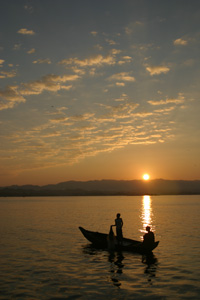Bangladesh. A Country of Natural beauty.
Bangladesh has been aptly described as a new state in an ancient land. Much has been written about the past glory of Bangladesh, notably in old records like the evidence of Pliny and Periplus of the Erythrean Sea (first century AD). It was drawn in Ptolemy's map. These indicate that from the earliest times Bangladesh was known to the West, particularly for its Muslin, the finest fabric the world has ever produced. Travellers and scholars who were attracted by the charms and fame of Bangladesh since time immemorial had showered effusive epithets on its bounties and wealth, affluence and prosperity, craftsmanship and cultural advancement.
They include the Chinese travellers Fa-hien (fourth century AD), Hue-an-tsung (seventh century), Ma-hoen and Fei-shin (fifteenth century), Ibne Batuta (fourteenth century) from Africa, Nicola Kanti (fifteenth century) and Ceasar the Frederik (sixteenth century) from Venice, Verthema, an Italian in the sixteenth century, Barbosa and Sebastin Manric (sixteenth century) from Portugal, Travernier and Bernier from France (seventeenth century) and Queen Elizabeth-the First's ambassador Ralf Fish.
To Ibne Batuta, Bangladesh was a 'hell full of bounties and wealthiest and cheapest land of the world.' So great were the attractions of Bangladesh that to quote Bernier 'it has a hundred gates open for entrance but not one for departure.' Ladies of Imperial Rome were literally crazy for Bangladesh's Muslin and luxury items, which according to Pliny, resulted in serious drain of gold of the Empire. Because of its location, Bangladesh served as a flourishing entry port and intermediary in trade and commerce between South Asia and the Far East. The region also played a seminal role in disseminating its belief art and architecture in the wider world of Asia. Ancient Bangladesh took great pride as a coveted seat of learning and education and scholars from far away countries regularly flocked to its numerous universities and monasteries.
Etymologically, the word Bangladesh is derived from the cognate Vanga which was first mentioned in Aitarey Aranyaka, a Hindu scripture composed between 500 BC and 500 AD. Literally it means a wetland. Muslim merchants of Arab origin used to refer it as Bangalah from which its present nomenclature is believed to have gradually evolved.
Geological evidence indicates that much of Bangladesh was formed 1 to 6.5 million years ago during the tertiary era. Human habitation in this region, therefore, is likely to be very old with the evidence of Palaeolithic civilization dating back to about 1,00,000 years.
Bangladesh has an area of 148,393 sq km and occupies the apex of the arch formed by the Bay of Bengal into which all the rivers flowing through the country drain. Bangladesh has one of the most complex river systems in the world numbering about 230 with their tributaries having a total length of about 24,140 km. The climate of Bangladesh is characterised by high temperature and high humidity, heavy rainfall and marked seasonal variation. Daily temperature ranges from 10� C to 12� C in the cool months and in the other months it varies between 28� C and 40� C. Soil of Bangladesh may be divided into three main categories, namely hill soils (Chittagong and Sylhet regions), terrace soils (Barind and Madhupur tracts) and alluvial and flood plain soils.
Follow me
https://steemit.com/@selim420
Follow back. and unvoate my post.....
Congratulations @saifullahrayhan! You have completed some achievement on Steemit and have been rewarded with new badge(s) :
Click on any badge to view your own Board of Honor on SteemitBoard.
For more information about SteemitBoard, click here
If you no longer want to receive notifications, reply to this comment with the word
STOPnice